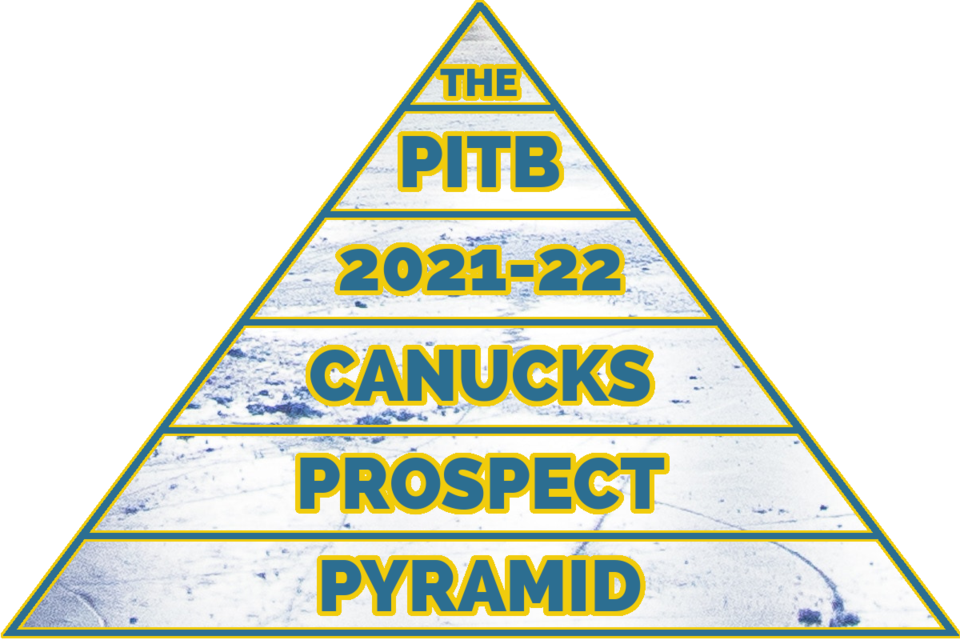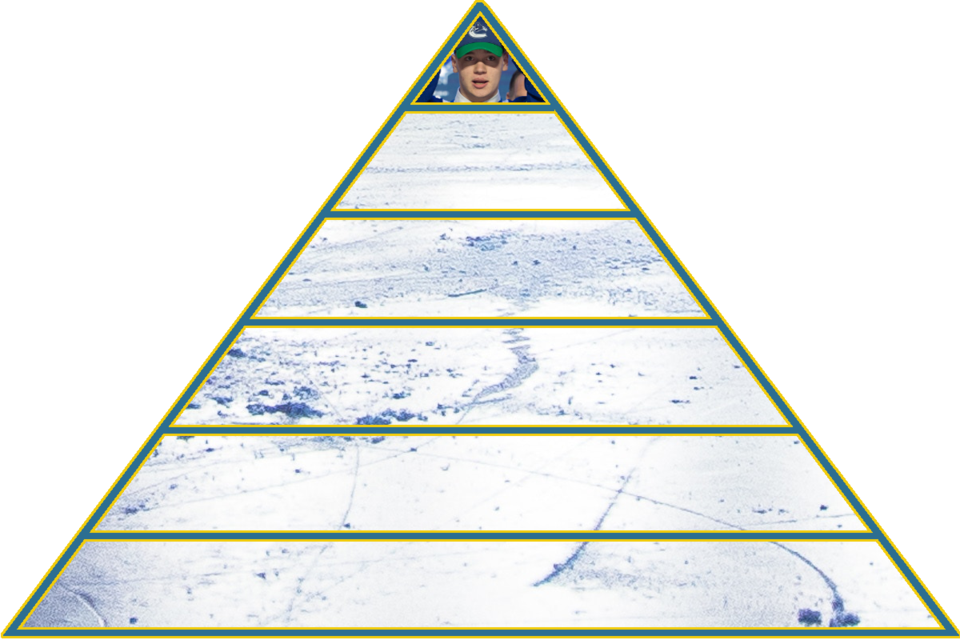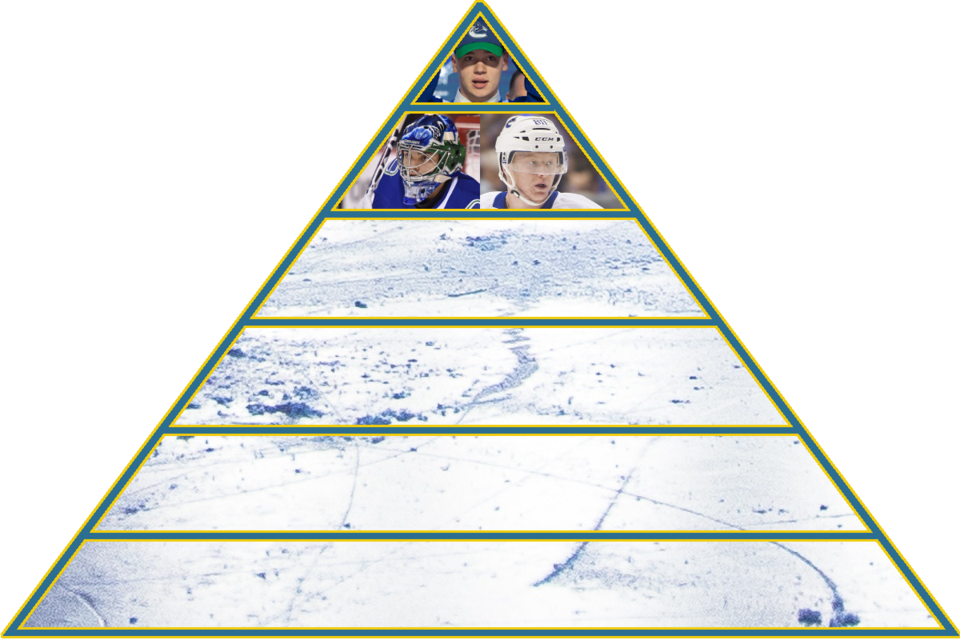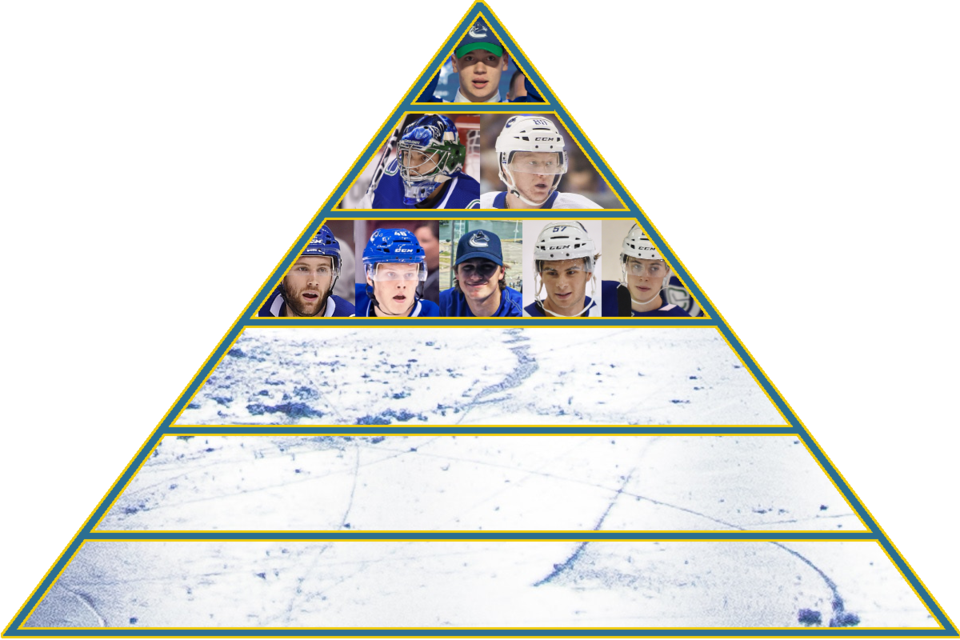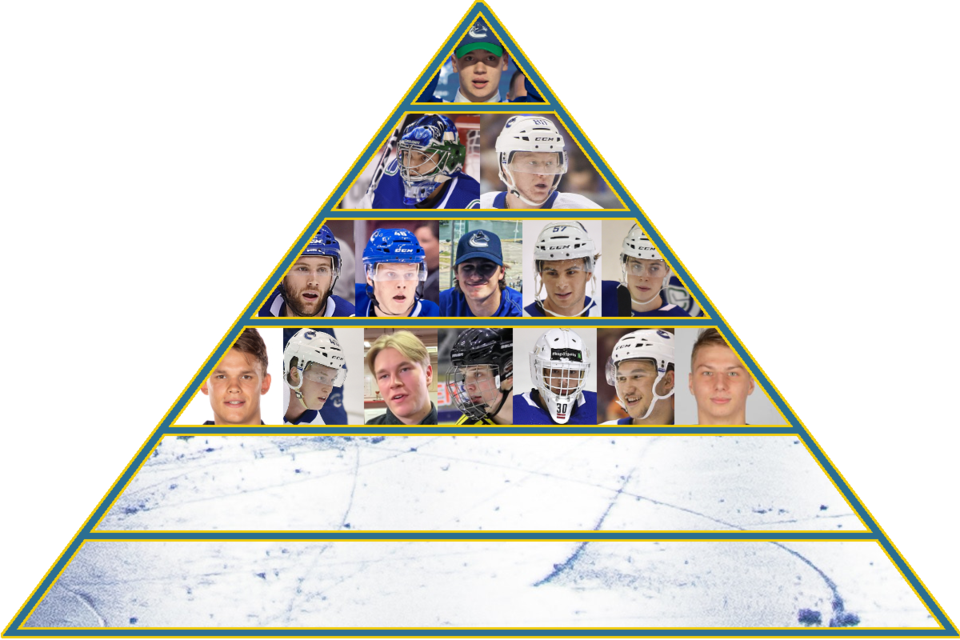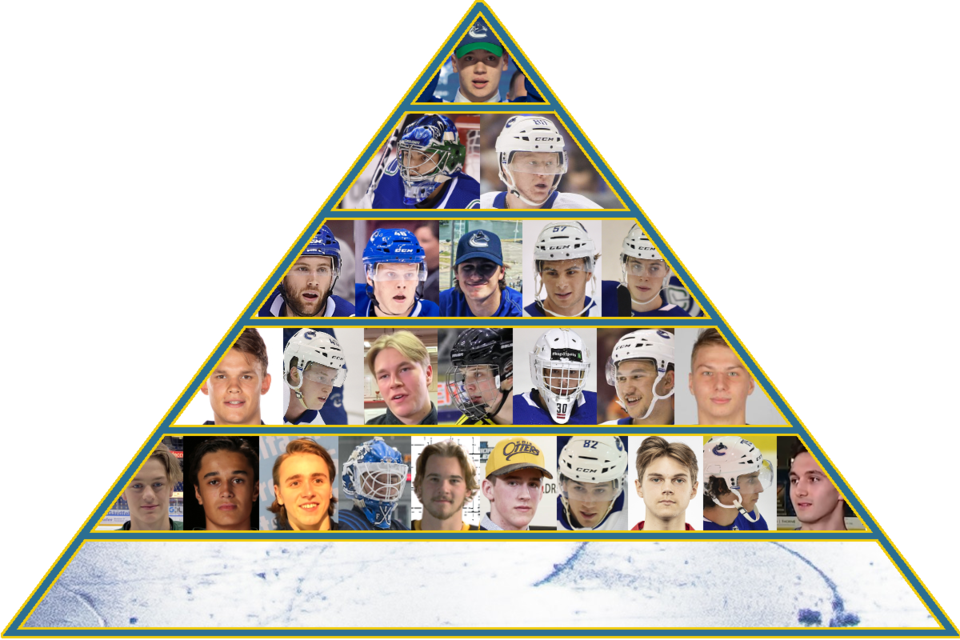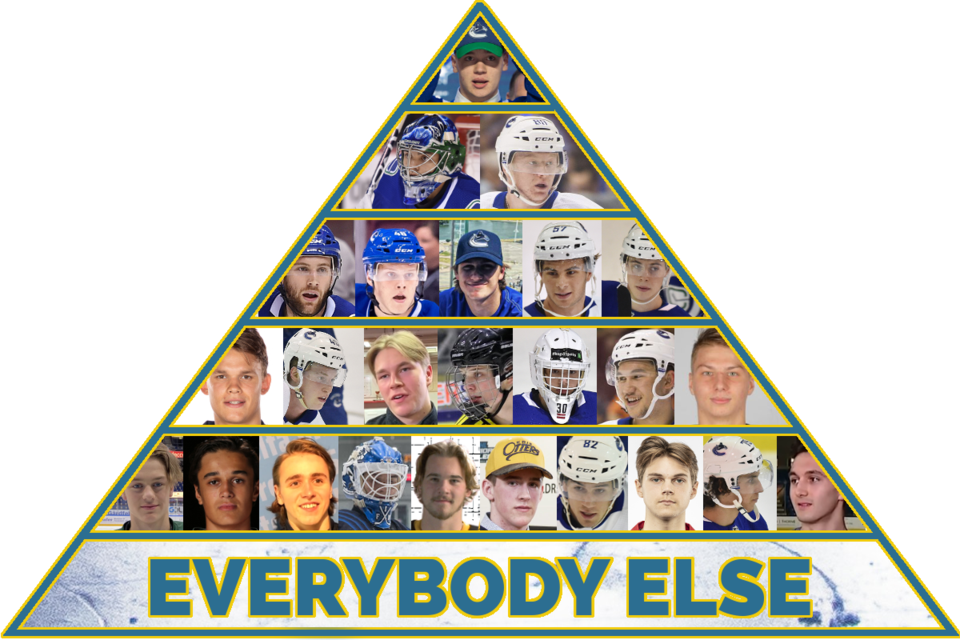Broke: Numbered lists to rank prospects.
Woke: Tiered lists to rank prospects.
Bespoke: Pyramids.
It is time to once again rank the Vancouver Canucks prospect pool using the building style favoured by ancient societies around the globe: the pyramid.
The idea of the prospect pyramid was originally borrowed from Steve Dangle. It’s a better way to rank prospects, as it doesn’t try to say who is better among the Canucks’ 7th-10th best prospects, but instead sorts them into tiers and then puts those tiers on an aesthetically-pleasing triangular shape.
As you would expect from a pyramid, it’s more narrow at the top, as a team naturally has fewer top-tier prospects. It’s wider at the bottom, as every team has plenty of bottom-tier prospects. It’s silly to try to judge who the Canucks’ 24th-best prospect is and elucidate the qualities that make him better than the team’s 25th-best prospect, so they just go in the same tier.
Here’s the 2021-22 edition of the Canucks’ Prospect Pyramid, topped by a familiar face.
Tier 1
Just like last year, Vasily Podkolzin is the only prospect in the top tier. That’s what happens when you don’t have a first-round pick in back-to-back entry drafts — you miss out on having two more blue-chip prospects. After Podkolzin makes the jump to the NHL in the coming season, this top tier will be empty.
Podkolzin isn’t your typical blue-chip prospect and it’s worth keeping expectations for his rookie season in check. He might not become a superstar or a consistent 30-goal scorer or ever score at a point-per-game pace, but his impact as a two-way, puck-possession winger could be profound.
The potential for Podkolzin to become a lesser version of Mark Stone easily lands him on top of the pyramid.
Tier 2
Two Canucks prospects land in the second tier, which is for players who could still be impact players some day: top-six forwards, top-four defencemen, or starting goaltenders.
The development of Jack Rathbone has been massive for a Canucks’ system that has struggled to turn out defencemen aside from Quinn Hughes. Rathbone was a fourth-round pick in 2017 but is now their top prospect on defence after a couple of stellar seasons with Harvard University in the NCAA.
The 22-year-old will battle to make the Canucks out of training camp with Olli Juolevi and veteran Brad Hunt but his 9 points in 8 AHL games last season as a rookie suggests he’s far too good for the AHL level and should be playing in Vancouver. His offensive tools are all borderline elite — skating, stickhandling, vision and shot — and his defensive game is better than some might expect.
Rathbone might not get power play time with Oliver Ekman-Larsson now on the team, which is a shame, as he has the potential to be a very good power play quarterback in the NHL. He could still get opportunities on the power play if and when injuries strike.
Last year, two other prospects joined Rathbone in the second tier: Olli Juolevi and Nils Höglander. The latter made the jump to the NHL incredibly successfully, establishing himself as a legitimate top-six winger. Juolevi had a shakier rookie season and has been bumped down to the third tier for reasons I’ll get into in a moment.
Now joining Rathbone is Michael “Mikey” DiPietro, up from the third tier last year. Despite a season largely spent on the sidelines in the Canucks’ taxi squad, there are good reasons to believe that DiPietro’s future is brighter than ever.
One is how diligent DiPietro was to continue improving despite the lack of playing time. He worked tirelessly with goaltending coach Ian Clark and, when he finally got the chance to play games in the AHL, he put up a .916 save percentage in four games with the Utica Comets.
Even Clark had to admit that the odd season likely delayed DiPietro’s development but he’s still incredibly high on the 22-year-old goaltender. He has the potential to be a solid starting goaltender in the NHL in the future, which lands him in the second tier.
For the time being, however, he’ll be the starting goaltender for the Abbotsford Canucks.
Tier 3
Prospects in the third tier may still have an NHL future but if they do, they’re more likely to be a bottom-six forward, bottom-pairing defenceman, or backup goaltender. Some might have a higher ceiling but are more of a longshot to reach that ceiling.
A year ago, Jonah Gadjovich slid down to the fifth tier in my prospect pyramid but a fantastic AHL season where he scored 15 goals in 19 games saw him clamber up the pyramid like he was on American Gladiators.
So, why Tier 3? 15 goals in 19 games is incredibly impressive but the issue is that there are still some serious concerns over whether he can stick at the NHL level. His skating, though improved, still needs work and he looked out of place in his all-too-short one-game audition with the Canucks last season.
Gadjovich puts in the work and has taken some incredible steps forward, so you can’t count him out. He may yet have an NHL future with his size, mean streak, and ability to bang in pucks in front of the net.
Then there’s Olli Juolevi, once the team’s best prospect on defence. Juolevi finally made his regular season debut with the Canucks, playing 23 games, with somewhat mixed results. At times he looked right at home in the NHL — at other times, he was exposed for his limited mobility when defending the rush.
Juolevi still looks like a player with an NHL future but it seems more likely that future will be on the third pairing. Still, maybe he can take a step forward after his rocky introduction to the NHL last season and prove me wrong.
The Canucks’ most intriguing prospect is their first pick from this year’s draft, Danila Klimovich, taken in the second round. Klimovich was a home run swing — a raw talent who has the potential to be a top-six, goal-scoring forward in the NHL.
The issue is that he lacks structure to his game and has flaws in his skating that will need to be addressed. He’s too much of a boom-or-bust prospect to land in the second tier, so drops down to the third.
Klimovich is likely to play in the QMJHL in the coming season, where he’ll hopefully get the coachinig and structure he needs to develop into a top-tier talent for the Canucks.
William Lockwood has the potential to make the Canucks out of training camp as a bottom-six energy winger but is more likely to start the season in the AHL, particularly as a waiver-exempt player.
Lockwood played two games for the Canucks last season and his speed was immediately noticeable. He’s got the wheels to stand out in the NHL even if he might not have all of the other tools to go with it. Speed and a willingness to play the body on the forecheck will get you a long way and he had a decent 11 points in 24 games as an AHL rookie last year.
Aidan McDonough had 20 points in 21 games in the NCAA last season, proving he could put up points without former Canucks prospect Tyler Madden feeding him the puck.
McDonough has some power forward potential and has an NHL-caliber shot, which is particularly effective with the man advantage. What remains to be seen is if he can take steps forward with his skating and become more than just a power play threat, but a well-rounded player that can play a middle-six role in the NHL.
If McDonough can break out as a junior with Northeastern, the Canucks will likely look to get him signed towards the end of the 2021-22 season to avoid him returning to college for his senior year and become a free agent.
Tier 4
Some of the players in the fourth tier could make the NHL but they have a longer road ahead of them or have hit some trials or snares along the way.
Let’s start with Arvid Costmar, who has thrived at lower levels in Sweden and even looked decent at the World Junior Championship, but has struggled when playing against men in the SHL. He’s got skill and energy in his game, but he also lacks size and has trouble asserting himself against bigger players. This will be a big season for him in the SHL.
The Canucks are high on Carson Focht, which bumps him up from the fifth tier. He’s got a solid defensive game and put up 12 points in 28 games in the AHL last season. As one of the few true centres in the Canucks’ prospect pool, he has a fairly clear path ahead of him to make the NHL.
The question is whether Focht has the puck skills to hold his own at the NHL level. That’s what remains to be seen, but he has the potential to bump up a tier or two in the coming year.
I was hoping for more from Joni Jurmo this season, I’ll admit. The big and speedy defenceman didn’t take a big step forward in Finland after the Canucks picked him in the third round last year. He had no points in 20 games in the Finnish Liiga and his corsi percentage was the worst on the team.
Jurmo ended up on loan to the second-tier Mestis league where he looked a lot more comfortable, putting up 8 points in 10 games. He’ll join Jukurit next year under head coach Olli Jokinen, who says Jurmo needs “physical as well as mental development to be able to reach his goals.”
There are people within the Canucks organization who are high on Viktor Persson and it would be a big help to the team’s depth if the seventh-round pick can make the NHL. Persson has the skating and playmaking to play at the NHL level but needs some time to develop.
Persson played just four games in the SHL last season, then put up 6 points in 11 games in the HockeyEttan, the third-tier professional league in Sweden. It will be interesting to see what he can do with a full season at one level instead of bouncing around as he did in the COVID-interrupted 2020-21 season.
Arturs Silovs is a key prospect for the Canucks as the team's second-best goaltending prospect after DiPietro. Like DiPietro, he saw limited playing time last season, playing a handful of games in Latvia and just one game in the AHL. He did get some key time in practice with Ian Clark, who is high on his ability to reach the next level. He has the potential to battle for a backup role in the future.
Jett Woo is a player I am very excited to see play in Abbotsford next season after 5 points in 28 AHL games as a rookie. Woo plays a physical style of defence that has some calling him a throwback player, but he also has the skating and puck skills to play a puck-moving game. There’s potential for an NHL defenceman in Woo, but there’s still some work to do to get there.
Finally, there’s Dmitri Zlodeyev, a faceoff-winning, defensively-responsible centre in a Russian junior league that rarely sees much defensive responsibility. Zlodeyev had 12 points in 16 games in the MHL, then proved he can score against men with 7 goals in 19 games in the VHL, the second-tier men’s league in Russia.
Zlodeyev has the potential to be a bottom-six centre in the NHL with his polished defensive game and he has a pinch of offensive upside as well. Whether he moves up a tier or two or falls off in the coming year will depend on how he handles KHL competition and how he performs for Russia at the World Junior Championship in his final year of eligibility.
Tier 5
There’s nothing wrong with being in the fifth tier and there’s a possibility that some of these players could play NHL games. Typically, a fifth-tier prospect is unlikely to stick in the NHL long-term but is more likely to be a bubble player that gets a few games here or there.
That said, a strong season can change perceptions of a prospect — both Lockwood and Gadjovich were in the fifth tier last year and got bumped all the way up to the third tier this year.
Several of the Canucks’ picks from the 2021 NHL Entry Draft land in this tier. This isn’t meant to be a slight against them — it’s just the reality of getting picked in the fifth, sixth, and seventh rounds. Several of these players have the potential to move up a tier or more in the future but, for now, we don’t really know just how good they might be and there’s a reason why they weren’t selected in a higher round.
Lucas Forsell was the Canucks’ final pick of the 2021 draft and was one of the youngest players available. He produced at both the under-18 and under-20 level in Sweden and he’s got energy and tenacity to go with some great hands and playmaking ability.
The issue with Forsell is he’s got limited experience playing at a higher level. It’s entirely up in the air what he might be able to do if he gets time in the SHL next season — he could crash and burn or he could excel. That uncertainty keeps him in the fifth tier.
Defenceman Hugo Gabrielson is strong in his own end of the ice and might have some offensive upside with his willingness to jump up in the play and his 13 points in 17 games in the under-20 Nationell league in Sweden. The question is again what he can do at higher levels and he’ll have the opportunity to prove himself in the Allsvenskan next season.
Centre Linus Karlsson was acquired from the San Jose Sharks for Jonathan Dahlen. Both of them were top scorers in the Allsvenskan this past season, with the older Dahlen putting up 71 points in 45 games to lead the league and Karlsson finishing 8th in scoring with 51 points in 52 games.
That’s solid production, but there are still question marks surrounding Karlsson’s skating and whether he has an NHL future. He’ll turn 22 next season and will be playing in the SHL for the first time. The Canucks will lose his rights after next season if they don’t sign him.
The Canucks needed to add to their goaltending depth in their prospec pool, so selected Aku Koskenvuo in the fifth round. The Finnish goaltender has size, athleticism, and problem-solving abilities but what he doesn’t have is a strong track record. He got lit up at the World Under-18 Championship, though he had flashes of brilliance, and had a middling .893 save percentage in junior.
Koskenvuo has potential but he has a long way to go to reach that potential.
Jackson Kunz spent last season in the USHL, where he had 43 points in 50 games for the Green Bay Gamblers. It was a good but not great season for Kunz, who had previously racked up goals in high school hockey. His lack of footspeed was a limitation and his future as a prospect likely depends on him taking a major step forward in that area as he heads to the University of North Dakota next season.
The Canucks took an intriguing chance at the draft on Connor Lockhart, who didn’t play a single game in his draft year because the OHL canceled the season. Before the draft, however, Lockhart was a highly-regarded prospect, whose skill and hockey sense made up for his lack of size. Like Idina Menzel and Brendon Urie, we’re going into the unknown with Lockhart.
Jack Malone saw his NCAA season get cancelled, so he returned to the USHL, where he led the Youngstown Phantoms with 41 points in 44 games. At 20 years old and with NCAA experience, however, it would have been reasonable to expect a little more. How he performs next season could be very telling.
The Canucks added depth to the right side on defence when they selected Jonathan Myrenberg in the fifth round. He’s got upside on both sides of the puck, with a heavy shot and a physical edge.
Myrenberg split time between the under-20 Nationell league and the third-tier HockeyEttan last season, putting up a combined 18 points in 30 games between the two leagues. Like other picks from that draft, he’s untested at higher levels, leaving a lot of uncertainty of how good he might be.
Karel Plasek was in the sixth tier last year but gets bumped up a tier with news that he’s signed with the Canucks and will play in the AHL next season. That’s somewhat surprising given that he showed little signs of taking a major step forward in the Czech league, putting up 10 points in 44 games, but the Canucks clearly see potential in the sixth-round pick.
Plasek does have a decent two-way game and might find a fit in a bottom-six role with the Abbotsford Canucks. Hopefully, he can develop into a player capable of playing that role in Vancouver as well.
Finally, there’s defenceman Jacob Truscott, who gets bumped down from the fourth tier after a lacklustre NCAA season where he had 5 points in 26 games. Truscott showed some major potential in his draft year with his slick skating and passing ability, but had to adjust his game as a college freshman.
Producing as a freshman can be a challenge, particularly when there are defencemen like Owen Power and Cam York ahead of you on the depth chart, so perhaps he can take a bigger step forward as a sophomore. It helps that he was forced to work more on his defensive game and penalty killing.
A big season and making Team USA in the World Junior Championship could see Truscott bounce back up the pyramid like Q*Bert.
Tier 6
This is the tier for the rest of the Canucks’ system. Regrettably, the odds of prospects in this tier making the NHL are rather slim.
This includes Lukas Jasek, who left the AHL to return to Europe, where he'll play in the Finnish Liiga, and Artyom Manukyan, whose development has seemingly sputtered out in Russia and is unlikely to come to North America.
Players from this tier can sometimes surprise and perhaps Toni Utunen is the most likely candidate. The Finnish defenceman plays a safe, simple game but doesn’t stand out much. Maybe that will change as the 21-year-old plays for a new team in the Finnish Liiga in the coming season.
